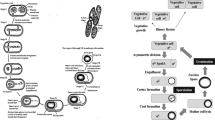Abstract
The ultrastructure of asexual spores (conidia) produced by the mycelial form of Paracoccidioides brasiliensis was studied for the first time with transmission electron microscopy, using thin sections of aldehyde-osmium-fixed and epoxy-resin-embedded samples. The various types of conidia observed in the sections correlated well with previous light-microscopic descriptions. These types were intercalary or apical conidia, depending on their location along the originating hyphae. As in previous studies they were characterized as arthroconidia, aleuriospores and sessile or pedunculate pyriform conidia. The sporogenous cells were clearly distinguished from hyphal cells by the thickness and appearance of their cell walls. Copious fibrillar material (glycocalyx) detected at the cell surface was stained with ruthenium red during the fixation process. Typical subcellular organelles (nucleus, nucleolus, mitochondria, ribosomes, etc) were found in most of the sections. It was concluded that the spores produced by the mycelial phase of P. brasiliensis possess all attributes of viable and physiologically competent eukaryotic cells.
Similar content being viewed by others
References
Lacaz CS. South American blastomycosis. An Fac Med São Paulo 1956; 29: 9–120.
Mackinnon JM. On the importance of South American blastomycosis. Mycopath Mycol Appl 1970; 41: 187–93.
Rubistein P, Negroni R. Micosis broncopulmonares del adulto y del Nino. 2nd ed. Buenos Aires: Editorial Beta 1981: 197–8.
San-Blas F and San-Blas G. Paracoccidioides brasiliensis. In: Szaniszlo PJ, Harris JL (eds). Fungal dimorphism with emphasis on fungi pathogenic for humans. New York: Plenum Press 1985: 93–120.
Emmons CW, Binford CH, Utz JP. Medical mycology. Philadelphia: Lea and Febiger, 1963.
Lacaz CS, Porto E, Costa-Martins JE. Micologia medica. 7th ed. São Paulo: Savier, 1984: 190–1.
Borelli D. Las aleurias de Paracoccidioides brasiliensis. Memorias IV Congreso Venezolane de Ciencias Médicas 1955; 4: 2241–53.
Neves JA, Bogliolo L. Researches on the etiological agents of the American blastomycosis. Mycopath Mycol Appl 1951; 5: 133–42.
Pollak L. Aleuriospores of Paracoccidioides brasiliensis. Mycopathol Mycol Appl 1971; 45: 217–9.
Bustamante-Simon B, McEwen JG, Tabares AM, Arango M, Restrepo-Moreno A. Characteristics of the conidia produced by the mycelial form of Paracoccidioides brasiliensis. Sabouraudia 1985; 23: 407–14.
Restrepo A. The ecology of Paracoccidioides brasiliensis: a puzzle still unsolved. Sabouraudia 1985; 23: 323–34.
Restrepo A. A reappraisal of the microscopical appearance of the mycelial phase of Paracoccidioides brasiliensis. Sabouraudia 1970; 8: 141–4.
Albornoz MB. Isolation of Paracoccidioides brasiliensis from rural soil in Venezuela. Sabouraudia 1971; 9: 248–53.
Negroni P. El P. brasiliensis vive saprofiticamente el el suelo argentine. Prensa Medica Argentina 1966; 53: 2831–2.
Restrepo BI, McEwen JG, Salazar MA, Restrepo A. Morphological development of the conidia produced by Paracoccidioides brasiliensis mycelial form. J Med Vet Mycol 1986; 24: 337–9.
McEwen JG, Bedoya V, Patino MM, Salazar ME, Restrepo A. Experimental murine paracoccidioidomycosis induced by the inhalation of conidia. J Med Vet Mycol 1987; 25: 165–75.
Restrepo A, Jimenez BE. Growth of Paracoccidioides brasiliensis yeast phase in a chemically defined culture medium. J Clin Microbiol 1980; 12: 279–81.
Ellis JJ, Ajello L. An unusual source for Apophysomyces elegans and a method for stimulating sporulation of Saksenaea vasiformis. Mycologia 1982; 74: 144–5.
Restrepo A, Salazar ME, Cano LE, Patino MM. A technique to collect and dislodge conidia produced by Paracoccidioides brasiliensis mycelial form. J Med Vet Myc 1986; 24: 247–50.
Glauert AM. Fixation, dehydration and embedding of biological specimens. Amsterdam: North Holland Publishing Co, 1975: 123–76.
Hayat MA. Basic techniques for transmission electron microscopy. London: Academic Press, 1986.
Luft JH. Ruthenium red and violet II. Fine structural localization in animal tissues. Anat Rec 1971; 171: 369–416.
Bedout C, Cano LE, Tabares AM, Van de Ven M, Restrepo A. Water as a substrate for the development of Paracoccidioides brasiliensis mycelial from Mycopathologia 1986; 96: 123–30.
Carbonell LM, Gil F. Ultrastructura del Paracoccidioides brasiliensis. In: Negro G, Lacaz CS and Fiorillo AM, eds, Paracoccidioidomicose (Blastomicose Sulamericana). São Paulo: Savier, 1982: 23–34.
Carbonell LM, Rodriguez J. Mycelial phase of Paracoccidioides brasiliensis and Blostomyces dermatitidis: an electron microscope study. J Bact 1968; 96: 533–43.
Furtado JS, Brito T, Freymuller E. The structure and reproduction of Paracoccidioides brasiliensis in human tissue. Sabouraudia 1967; 5: 226–9.
Paris S, Prevost MC, Latge JP, Garrison RG. Cytochemical study of the yeast and mycelial cell walls of Paracoccidioides brasiliensis. Exper Mycol 1986; 10: 228–42.
McEwen JG, Restrepo BI, Salazar ME, Restrepo A. Nuclear staining of Paracoccidioides brasiliensis conidia. J Med Vet Mycol 1987: 25: 343–5.
Author information
Authors and Affiliations
Rights and permissions
About this article
Cite this article
Edwards, M.R., Salazar, M.E., Samsonoff, W.A. et al. Electron microscopic study of conidia produced by the mycelium of Paracoccidioides brasiliensis . Mycopathologia 114, 169–177 (1991). https://doi.org/10.1007/BF00437210
Received:
Accepted:
Issue Date:
DOI: https://doi.org/10.1007/BF00437210




